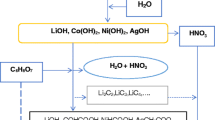Abstract
This article deals with the properties of high-voltage cathode material LiNi0.5Mn1.5O4 synthesised by a solid-state reactions method. The sample—LiNi0.5Mn1.5O4—was synthesised by two steps of annealing process. A number of electrochemical and physical methods were used to analyse the samples. The obtained LiNi0.5Mn1.5O4 powder was characterised by scanning electron microscopy (SEM), energy-dispersive X-ray spectroscopy (EDS) and galvanostatic charge/discharge measurements at different loads and high temperature in lithium-ion cells with metal lithium as a counter electrode. All these analyses were used for confirmation of the structure of the material LiNi0.5Mn1.5O4 and for investigating its electrochemical properties. A special analysis was used for this paper to understand and confirm the function of this type of material. It is called electron paramagnetic resonance (EPR) spectroscopy, which is used in the field of lithium-ion batteries and also which is not common. This analysis is typically used to analyse free radicals. It is possible to study changes of valence in cathode materials during charging and confirming the valence change of Mn from Mn3+ to Mn4+ and of Ni from Ni2+ to Ni3+ and then to Ni4+ with EPR analysis. Thermogravimetric (TG) analysis of stability of the material LiNi0.5Mn1.5O4 with in situ observation of structural changes by SEM was used as the last analysis.














Similar content being viewed by others
References
Ohzuku T, Brodd RJ (2007) An overview of positive-electrode materials for advanced lithium-ion batteries. J Power Sources 174(2):449–456
Belharouak I (2012) Lithium ion batteries—new developments. InTech.
Brodd R. J (2012) Batteries for sustainability: selected entries from the encyclopedia of sustainability science and technology. Springer 519
Hu M, Pang X, Zhou Z (2013) Recent progress in high-voltage lithium ion batteries. J Power Sources 237:229–242
Yoo HD, Markevich E, Salitra G, Sharon D, Aurbach D (2014) Mater Today 17:110
Xu B, Qian D, Wang Z, Meng YS (2012) Recent progress in cathode materials research for advanced lithium ion batteries. Mater Sci Eng R Rep:51–65
Patoux SB, Daniel L, Bourbon C, Lignier H, Pagano C, Le Cras F, Jouanneau S, Martinet S (2009) High voltage spinel oxides for Li-ion batteries: from the material research to the application. J Power Sources 189(1):344–352
Chen X, Xu W, Xiao J, Engelhard MH, Ding F, Mei D, Hu D, Zhang J, Zhang J-G (2012) Effects of cell positive cans and separators on the performance of high-voltage Li-ion batteries. J Power Sources 213:160–168
Qian Y, Deng Y, Shi Z, Zhou Y, Zhuang Q, Chen G (2013) Sub-micrometer-sized LiMn1.5Ni0.5O4 spheres as high rate cathode materials for long-life lithium ion batteries. Electrochem Commun 27:92–95
Sha O, Qiao Z, Wang S, Tang Z, Wang H, Zhang X, Xu Q (2013) Improvement of cycle stability at elevated temperature and high rate for LiNi0.5-xCuxMn1.5O4 cathode material after Cu substitution. Mater Res Bull 48(4):1606–1611
Xiao J, Chen X, Sushko PV, Sushko ML, Kovarik L, Feng J, Deng Z, Zheng J, Graff GL, Nie Z, Choi D, Liu J, Zhang J-G, Whittingham MS (2012) High-performance LiNi0.5Mn1.5O4 spinel controlled by Mn3+ concentration and site disorder. Adv Mater 24(16):2109–2116
Ariyoshi K, Iwakoshi Y, Nakayama N, Ohzuku T (2004) Topotactic two-phase reactions of Li[Ni1/2Mn3/2]O4 (P4332) in nonaqueous lithium cells. J Electrochem Soc 151(2):A296–A303
Aurbach D, Markovsky B, Salitra G, Markevich E, Talyossef Y, Koltypin M, Nazar L, Ellis B, Kovacheva D (2007) Review on electrode and electrolyte solution interactions, related to cathode materials for Li-ion batteries. J Power Sources 165(2):491–499
Shao-Horn Y, Middaugh RL (2001) Redox reactions of cobalt, aluminum and titanium substituted lithium manganese spinel compounds in lithium cells. Solid State Ionics 139(1–2):13–25
Kawai H, Nagata M, Tukamoto H, West AR (1999) High-voltage lithium cathode materials. J Power Sources 81–82:67–72
Gao Y, Myrtle K, Zhang M, Reimers JN, Dahn JR (1996) Valence band of LiNixMn2−xO4 and its effects on the voltage profiles of LiNixMn2−xO4/Li electrochemical cells. Phys Rev B 54(23):16670–16675
Kim JH, Yoon CS, Myung ST, Prakash J, Sun YK (2004) Phase transitions in Li1− δNi0.5Mn1.5O4 during cycling at 5 V. Electrochem Solid-State Lett 7(7):A216–A220
Kim JH, Myung ST, Yoon CS, Kang SG, Sun YK (2004) Comparative study of LiNi0.5Mn1.5O4-δ and LiNi0.5Mn1.5O4 cathodes having two crystallographic structures: Fd3m and P4332. Chem Mater 16(5):906–914
Nie X, Zhong B, Chen M, Yin K, Li L, Liu H, Guo X (2013) Synthesis of LiCr0.2Ni0.4Mn1.4O4 with superior electrochemical performance via a two-step thermo polymerization technique. Electrochim Acta 97:184–191
Kazda T, Vondrák J, Di Noto V, Straková Fedorková A, Sedlaříková M, Čudek P, Vyroubal P (2014) The influence of used precursors on the properties of high-voltage cathode materials. J Solid State Electrochem 1–7. doi:10.1007/s10008-014-2633-6
Hong KJ, Sun YK (2002) Synthesis and electrochemical characteristics of LiCrxNi0.5-xMn1.5O4 spinel as 5 V cathode materials for lithium secondary batteries. J Power Sources 109(2):427–430
Acknowledgments
This research work has been carried out in the Centre for Research and Utilization of Renewable Energy (CVVOZE). Authors gratefully acknowledge financial support from the Ministry of Education, Youth and Sports of the Czech Republic under NPU I programme (project No. LO1210), BUT specific research programme (project No. FEKT-S-14-2293) and FEI Company.
Author information
Authors and Affiliations
Corresponding author
Rights and permissions
About this article
Cite this article
Kazda, T., Vondrák, J., Di Noto, V. et al. Study of electrochemical properties and thermal stability of the high-voltage spinel cathode material for lithium-ion accumulators. J Solid State Electrochem 19, 1579–1590 (2015). https://doi.org/10.1007/s10008-015-2772-4
Received:
Revised:
Accepted:
Published:
Issue Date:
DOI: https://doi.org/10.1007/s10008-015-2772-4




